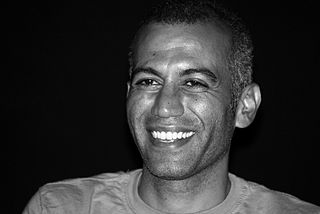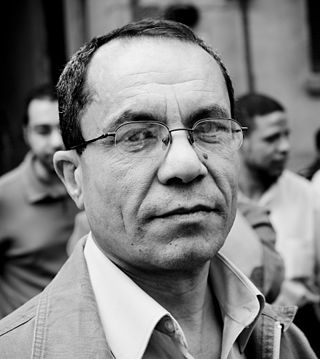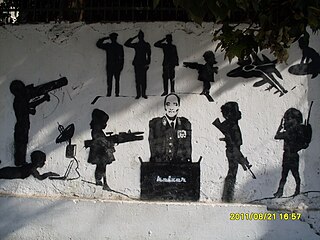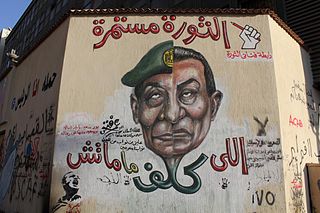
The 2011 Egyptian revolution, also known as the 25 January Revolution, began on 25 January 2011 and spread across Egypt. The date was set by various youth groups to coincide with the annual Egyptian "Police holiday" as a statement against increasing police brutality during the last few years of Hosni Mubarak's presidency. It consisted of demonstrations, marches, occupations of plazas, non-violent civil resistance, acts of civil disobedience and strikes. Millions of protesters from a range of socio-economic and religious backgrounds demanded the overthrow of Egyptian President Hosni Mubarak. Violent clashes between security forces and protesters resulted in at least 846 people killed and over 6,000 injured. Protesters retaliated by burning over 90 police stations across the country.

The following is a chronological summary of the major events that occurred during the Egyptian Revolution of 2011, after Hosni Mubarak's resignation. Protests and riots led to the deaths of hundreds, injuries of thousands and the arrests of tens of thousands. Millions have mobilised the streets since the revolution.

Hossam el-Hamalawy is an Egyptian journalist, blogger, photographer and socialist activist. He is a member of the Revolutionary Socialists and the Center for Socialist Studies.

Human rights in the post-Mubarak transition have been the subject of concern and controversy since the 2011 Egyptian revolution. The Supreme Council of the Armed Forces (SCAF) Arabic: المجلس الأعلى للقوات المسلحة, al-Maǧlis al-ʾAʿlā lil-Quwwāt al-Musallaḥah in particular have been the focus of concerns about human rights violations. The SCAF, which consists of a body of 20 senior officers in the Egyptian military, was handed the power to govern Egypt after the ouster of President Hosni Mubarak on 11 February 2011 as a consequence of the revolution.

Hamdeen Sabahi is an Egyptian politician, journalist. He is currently the leader of the Egyptian Popular Current and a co-leader of the National Salvation Front. An opposition activist during the Anwar Sadat and Hosni Mubarak eras, Sabahi was jailed 17 times during their presidencies for political dissidence. He was an immediate supporter and participant of the 2011 Egyptian revolution. Sabahi entered the 2012 Egyptian presidential race in which he finished third place with 21.5% of the vote trailing the second place candidate Ahmed Shafiq by a margin of 700,000 votes. In the 2014 presidential election he was one of just two candidates. He ran second with less than 4% of the vote. Abdel Fattah el-Sisi was declared the winner after attracting 22 million of the nearly 23 million votes cast. Sisi was sworn into office as President of Egypt on 8 June 2014.

Kamal Abbas is General Coordinator of the Center for Trade Unions and Workers Services (CTUWS), an activist group for independent unions in Egypt. Involved in activism for over 20 years, Abbas has been active in mobilizing worker support during the Egyptian Revolution of 2011 and its aftermath. His approach emphasizes peaceful strikes and rallies accompanied by demands for better wages and working conditions, as well as more regular elections for union officials, and an independent union system.

Mohammed Khairat Saad el-Shater is an Egyptian engineer, businessman and Islamist political activist. A leading member of the Muslim Brotherhood, as the Deputy Supreme Guide, el-Shater was the initial candidate of the movement's Freedom and Justice Party during the 2012 Egyptian presidential election before being disqualified by the election commission. Previously, he was the deputy chairman of the Brotherhood.

Khaled Ali is an Egyptian lawyer and activist. He is known for his advocacy for reform of government and private sector corruption and for promoting social justice and labor rights. He is the former head of the Egyptian Center for Economic and Social Rights (ECESR), and co-founder of the Front for Defending Egyptian Protesters and the Hisham Mubarak Law Center (HMLC).
Ganzeer is the pseudonym used by an Egyptian artist who has gained mainstream fame in Egypt and internationally following the 2011 Egyptian Revolution. Prior to the revolution, Ganzeer's popularity was widespread yet limited to the spheres of art and design. Ganzeer's artwork has touched on the themes of civic responsibility and social justice and has been critical of the Supreme Council of the Armed Forces, or SCAF, which has ruled Egypt since the February 2011 resignation of former president Hosni Mubarak. Ganzeer means "chain" in Arabic. He is a regular contributor to the online magazine Rolling Bulb. Described by Bidoun Magazine as a "Contingency Artist," Ganzeer is quite accustomed to adopting completely new styles, techniques, and mediums to adapt to the topic he is tackling at any given time. The Huffington Post has placed him on a list of "25 Street Artists from Around the World Who Are Shaking Up Public Art," while Al-Monitor.com has placed him on a list of "50 People Shaping the Culture of the Middle East." He is one of the protagonists in a critically acclaimed documentary titled Art War by German director Marco Wilms. Ganzeer was also cited by German Arte as one of Egypt's highest-selling living artists today.
El Teneen is the pseudonym of an anonymous 39–40-year-old Egyptian street artist and graffiti artist whose work gained popularity and notoriety in Egypt following the 2011 Revolution. El Teneen originally formed one half of the pair "Team El Teneen", or "Dragon Team"; however, the artist now works primarily independently. His works of art have been described as "icons of the 25 January revolution."

Keizer is the pseudonym of an anonymous Egyptian street artist and graffiti artist whose work has gained popularity and notoriety in Egypt following the 2011 Egyptian Revolution. Keizer is reportedly a 33-year-old male who creates street art in Cairo full-time.

Mohamed Mahmoud Graffiti is a collection of graffiti that was painted on several walls in and surrounding Mohamed Mahmoud street near Tahrir Square in Cairo, Egypt during and after the 2011 Egyptian revolution.

The 2012–2013 Egyptian protests were part of the crisis in Egypt including the June 2013 protests, the July 2013 coup d'état, and part of the post-coup unrest. They saw varying opposition against three contiguous heads of state; namely, the Supreme Council of the Armed Forces (SCAF), Muslim Brotherhood, and the de facto ruling Egyptian Armed Forces.

Hend Kheera is an Egyptian street artist whose work features a mix of stencils and slogans. She is one of the leaders of Egypt's street-art boom since the 2011 uprising. Kheera has been an active participant in anti-sexual harassment campaign in Egypt in response to Mass sexual assault in Egypt

Aya Tarek is an Egyptian artist from the city of Alexandria. Tarek's mediums are primarily street art or graffiti and paint. Although street art in Egypt gained much international attention after the 2011 revolution, Tarek began sharing her street art on the walls of Alexandria in 2008, when she was 18. Tarek also produces indoor murals which she feels helps her in to be taken more seriously as an artist. However, she utterly stresses the importance of street art because it is accessible to anyone to take whatever they may need to from the work.
Contemporary art in Egypt is a term used to refer to visual art, including installations, videos, paintings, or sculptures, developed in the Egyptian art scene. While the contemporary art scene is mainly concentrated in Cairo and Alexandria, it is developing fast with the emergence of spaces for artists, and support from the public or from abroad. Many Egyptian artists use the Egyptian contemporary art scene as a ramp toward the international art scenes.

The 30 June protests occurred in Egypt on 30 June 2013, marking the one-year anniversary of Mohamed Morsi's inauguration as president. The events ended with the 2013 Egyptian coup d'état after mass protests across Egypt demanding the immediate resignation of the president. The rallies were partly a response to Tamarod, an ostensibly grassroots movement that launched a petition in April 2013, calling for Morsi and his government to step down. Tamarod claimed to have collected more than 22 million signatures for their petition by June 30, although this figure was not verified by independent sources. A counter-campaign in support of Morsi's presidency, named Tagarod, claimed to have collected 26 million signatures by the same date, but this figure was also unverified and not mentioned in media nearly as much as Tamarod's, with no reliable sources repeating it. The movements in opposition to Morsi culminated in the June 30 protests that occurred across the country. According to the Egyptian military, which calculated the number of protesters via helicopter scans of demonstration perimeters across the country, the June 30 protests had 32 million protesters, making them "the biggest protests in Egypt's history." However, independent observers raised concerns that the Egyptian government exaggerated the actual number of anti-Morsi protestors, with some research determining that only around one to two million people protested across the country against Morsi.

Hani Shukrallah was an Egyptian journalist and political analyst. He was managing editor of Al-Ahram Weekly from 1991 and 2005 and later founder and until February 2011 editor-in-chief of Ahram Online, both part of the state-run Al-Ahram Foundation. He was also the Executive Director of the Heikal Foundation for Arab Journalism.

Protests against the 2013 Egyptian coup d'état erupted in July 2013. Immediately following the removal of President Mohamed Morsi by the Egyptian Armed Forces on 3 July 2013 amid demonstrations against Morsi's rule, many protesters amassed near the Rabia Al-Adawiya Mosque to call for Morsi's return to power and condemn the military, while others demonstrated in support of the military and interim government. Deadly clashes such as Rabaa massacre continued for several days, with three particularly bloody incidents being described by officials as "massacres" perpetrated by security forces. During the month of Ramadan, prime minister Hazem al-Beblawy threatened to disperse the ongoing Pro-Morsi sit-ins in Rabaa al-Adaweya square and al-Nahda square. The government crackdown of these protests occurred in a violent dispersal on 14 August 2013. In mid-August, the violence directed by the army towards the protesters escalated, with hundreds killed, and the government declaring a month-long nighttime curfew.
Women on Walls is a public art project in Egypt aimed at empowering women through the use of street art, by encouraging the portrayal of strong Egyptian female figures in street art and empowering female street artists themselves to participate in the political space of graffiti. Building on the popularity of street art as a form of political expression during the January 25 revolution, the aim of this project is to increase awareness of women's issues by introducing women into public space. This project was co-founded by Mia Gröndahl, a Swedish street art documentarian, and Angie Balata, an Egyptian artist, in December 2012 with funding from the Danish Center for Culture and Development, and was launched with a month-long event in the Spring of 2013 in Cairo, Luxor, Alexandria, and Mansoura that included painting sessions, workshops, and lectures on topics ranging from art to women's issues more generally. The project held its second campaign in February 2014.















